Home
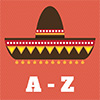 Traditional pieces of the male and female national costumes in Mexico: baja jacket, caites, charros, charro suit, china poblana, chincuete, cowboy boots, enagua, enredo, faja, guayabero, huaraches, huipil, mecapal, moral, pointy boots, poncho, posahuanco, rebozo, refajo, sarape, sombrero, tzute, quechquémitl.
Traditional pieces of the male and female national costumes in Mexico: baja jacket, caites, charros, charro suit, china poblana, chincuete, cowboy boots, enagua, enredo, faja, guayabero, huaraches, huipil, mecapal, moral, pointy boots, poncho, posahuanco, rebozo, refajo, sarape, sombrero, tzute, quechquémitl.
- Details
- Category: Mexico
- Hits: 3823
 Traditional weaving is an extremely important craft for Peru. The locals have been using woven garments and household items for thousands of years by now. And there’s even more to it. The native language of Andean people is Quechua, and originally it was an oral language, so Andeans needed some instrument to save and pass the stories, local history, and their thoughts and ideas to the next generations of just other communities. The woven textiles became a mean of communication between people and recording the knowledge.
Traditional weaving is an extremely important craft for Peru. The locals have been using woven garments and household items for thousands of years by now. And there’s even more to it. The native language of Andean people is Quechua, and originally it was an oral language, so Andeans needed some instrument to save and pass the stories, local history, and their thoughts and ideas to the next generations of just other communities. The woven textiles became a mean of communication between people and recording the knowledge.
- Details
- Category: Peru
- Hits: 25257
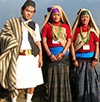 Nepal is a multicultural and multiethnic country because it was formed in the 18th century from several small kingdoms: Mustang, Madhesh, Videha (Mithila), and Limbuwan. Each of the ethnic groups – and there are more than a 100 of them in Nepal – has its own clothing traditions, folk costume and accessories, traditional jewelry pieces, and etc. The more interesting it is to learn about the traditional clothing of Nepal. Though, in this article, we’ll only tell you about the main garments included to the national costume of Nepal.
Nepal is a multicultural and multiethnic country because it was formed in the 18th century from several small kingdoms: Mustang, Madhesh, Videha (Mithila), and Limbuwan. Each of the ethnic groups – and there are more than a 100 of them in Nepal – has its own clothing traditions, folk costume and accessories, traditional jewelry pieces, and etc. The more interesting it is to learn about the traditional clothing of Nepal. Though, in this article, we’ll only tell you about the main garments included to the national costume of Nepal.
- Details
- Category: Nepal
- Hits: 77780
 Traditional pieces of the male and female national costumes in Lebanon: abaya, abba, agal, gambaz, jubbe, kabkab, kaffia, kubran, labbade, libas, mandeal, sherwal, tantur, tarboush, and taqiah.
Traditional pieces of the male and female national costumes in Lebanon: abaya, abba, agal, gambaz, jubbe, kabkab, kaffia, kubran, labbade, libas, mandeal, sherwal, tantur, tarboush, and taqiah.
- Details
- Category: Lebanon
- Hits: 5704
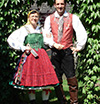 The national costume of Slovenia looks pretty European. Locals call it “Narodna noša”. It was established and unified in the 19th century. Until then, there were many regional Slovenian costumes with their unique features. Some areas used their folk clothing until the World War II. But nevertheless, today, Gorenjska (Upper Carniola) folk costume is considered the national dress of Slovenia. And Slovenians around the whole country use it.
The national costume of Slovenia looks pretty European. Locals call it “Narodna noša”. It was established and unified in the 19th century. Until then, there were many regional Slovenian costumes with their unique features. Some areas used their folk clothing until the World War II. But nevertheless, today, Gorenjska (Upper Carniola) folk costume is considered the national dress of Slovenia. And Slovenians around the whole country use it.
- Details
- Category: Slovenia
- Hits: 51781
Traditional attire of Ghana. Bright African patterns with deep meaning form great authentic garments
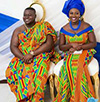 The traditional costumes of Ghana are not just beautiful. The culture of this country and its ancient heritage influence the folk clothing much. That’s why the designs, fabrics, and patterns aren’t random. They are used by Ghanaians for a long period of time, and therefore, they carry the old knowledge and tradition. At the same time, the national outfit of Ghana looks so bright and festive that it brightens the mood of everyone around.
The traditional costumes of Ghana are not just beautiful. The culture of this country and its ancient heritage influence the folk clothing much. That’s why the designs, fabrics, and patterns aren’t random. They are used by Ghanaians for a long period of time, and therefore, they carry the old knowledge and tradition. At the same time, the national outfit of Ghana looks so bright and festive that it brightens the mood of everyone around.
- Details
- Category: Ghana
- Hits: 176219
 Traditional pieces of the male and female national costumes in Malaysia: baju batik, batik, baju kebarung, baju kebaya, baju kurung, baju kurung kedah, baju melayu, ikat, kain, kemban, sampin, sarong, selendang, songket, songkok, tanjak, tengkolok, tudung.
Traditional pieces of the male and female national costumes in Malaysia: baju batik, batik, baju kebarung, baju kebaya, baju kurung, baju kurung kedah, baju melayu, ikat, kain, kemban, sampin, sarong, selendang, songket, songkok, tanjak, tengkolok, tudung.
- Details
- Category: Malaysia
- Hits: 7301
 The national costume of Norway is called “bunad”. It is a must-have for the natives, especially for women. But as for me, even if it wasn’t for the honor of old traditions, Norwegians should wear bunads just for their beauty. These costumes are real masterpieces, both modern and vintage ones. If to talk about the prettiest items of the outfit, they are definitely the silver jewels.
The national costume of Norway is called “bunad”. It is a must-have for the natives, especially for women. But as for me, even if it wasn’t for the honor of old traditions, Norwegians should wear bunads just for their beauty. These costumes are real masterpieces, both modern and vintage ones. If to talk about the prettiest items of the outfit, they are definitely the silver jewels.
- Details
- Category: Norway
- Hits: 81316
 Jamaican folk costumes are very bright, multicolored, organic, and breathy. Traditionally, they were made from locally produced handmade calico fabric. The pattern on the fabric was red&white plaid. An interesting piece of the Jamaican female folk dress is a headgear called “bandana”. It is connected to Asian traditions. Do you want to learn how and why? Read the article below.
Jamaican folk costumes are very bright, multicolored, organic, and breathy. Traditionally, they were made from locally produced handmade calico fabric. The pattern on the fabric was red&white plaid. An interesting piece of the Jamaican female folk dress is a headgear called “bandana”. It is connected to Asian traditions. Do you want to learn how and why? Read the article below.
- Details
- Category: Jamaica
- Hits: 67132
 Traditional pieces of the male and female national costumes in Czechia: baborák, blata plena, brslenky, bunda, caftan, cervenice, fěrtoch, honzík, lajblík, jelitko, oplicko, podstok, praštenky, rukávce, šněrovačka, uvodnice, velický, vinek, výkladek, and živůtek.
Traditional pieces of the male and female national costumes in Czechia: baborák, blata plena, brslenky, bunda, caftan, cervenice, fěrtoch, honzík, lajblík, jelitko, oplicko, podstok, praštenky, rukávce, šněrovačka, uvodnice, velický, vinek, výkladek, and živůtek.
- Details
- Category: Czech Republic
- Hits: 4470
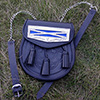 Every national costume in the world is complemented with accessories. And one of the main and most important accessories is a bag, pouch, or purse. There are thousands of designs, shapes, colors, embellishments, ornamentations, and purposes of folk bags. Each purse indicates the unicity of its country of origin, the local traditions, beliefs, and features of the local nature. We’d like to present you our rating of the most beautiful and interesting folk bags around the world.
Every national costume in the world is complemented with accessories. And one of the main and most important accessories is a bag, pouch, or purse. There are thousands of designs, shapes, colors, embellishments, ornamentations, and purposes of folk bags. Each purse indicates the unicity of its country of origin, the local traditions, beliefs, and features of the local nature. We’d like to present you our rating of the most beautiful and interesting folk bags around the world.
- Details
- Category: Nationalclothing
- Hits: 3364
 There is no single national costume in Malaysia. But all of the outfits can be divided into several main categories: Malay, Chinese, Indian, and Aboriginal dress (Orang Asli). Malaysia is a country where different cultures mix and intertwine. But the more interesting it is to learn about the clothing traditions of Malaysia. There is a wide variety of folk costumes used by the locals and the descendants of the immigrants from other countries: from simple outfits made of the natural materials to intricate attires adorned with complicated needlework.
There is no single national costume in Malaysia. But all of the outfits can be divided into several main categories: Malay, Chinese, Indian, and Aboriginal dress (Orang Asli). Malaysia is a country where different cultures mix and intertwine. But the more interesting it is to learn about the clothing traditions of Malaysia. There is a wide variety of folk costumes used by the locals and the descendants of the immigrants from other countries: from simple outfits made of the natural materials to intricate attires adorned with complicated needlework.
- Details
- Category: Malaysia
- Hits: 68199
 Traditional pieces of the male and female national costumes in the United Arab Emirates (UAE): abaya, agal, burqa, gafaaz, gishwa, gutrah, hijab, kandura, keffiyeh, niqab, sheila, thawb.
Traditional pieces of the male and female national costumes in the United Arab Emirates (UAE): abaya, agal, burqa, gafaaz, gishwa, gutrah, hijab, kandura, keffiyeh, niqab, sheila, thawb.
- Details
- Category: United Arab Emirates
- Hits: 29894
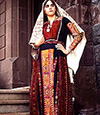 The folk clothing of Palestine is extremely rich in embroidery. By the way, the traditional embroidery is called “tatriz”, and it adds a distinctive Palestinian flavor to any dress. The complicated history of Palestine had a considerable influence on the national costume and clothing traditions of this country. But luckily, in modern times, the traditional outfit of Palestine experiences its flourishing. There is a boom of tatriz and Palestinian traditional garments within the country and far beyond its borders. Local manufacturers and Palestinian and Israeli merchants work hard to advertise these folk costumes and export them to every possible interested country of the world. So, let’s try to find out a little bit about this extraordinary folk clothes.
The folk clothing of Palestine is extremely rich in embroidery. By the way, the traditional embroidery is called “tatriz”, and it adds a distinctive Palestinian flavor to any dress. The complicated history of Palestine had a considerable influence on the national costume and clothing traditions of this country. But luckily, in modern times, the traditional outfit of Palestine experiences its flourishing. There is a boom of tatriz and Palestinian traditional garments within the country and far beyond its borders. Local manufacturers and Palestinian and Israeli merchants work hard to advertise these folk costumes and export them to every possible interested country of the world. So, let’s try to find out a little bit about this extraordinary folk clothes.
- Details
- Category: Palestine
- Hits: 54085
Page 63 of 70
